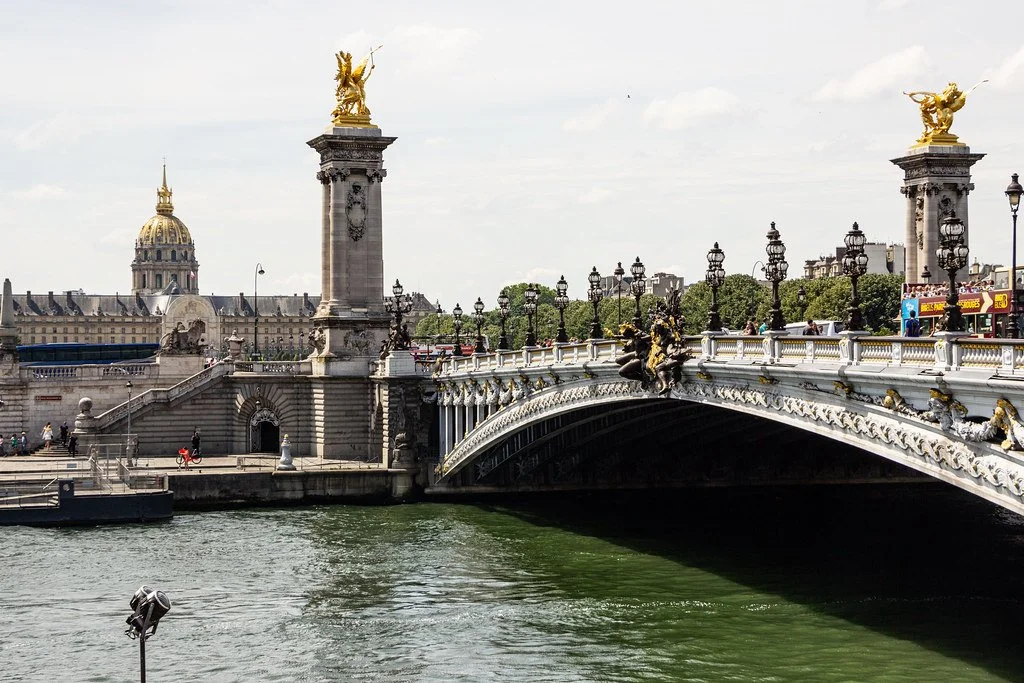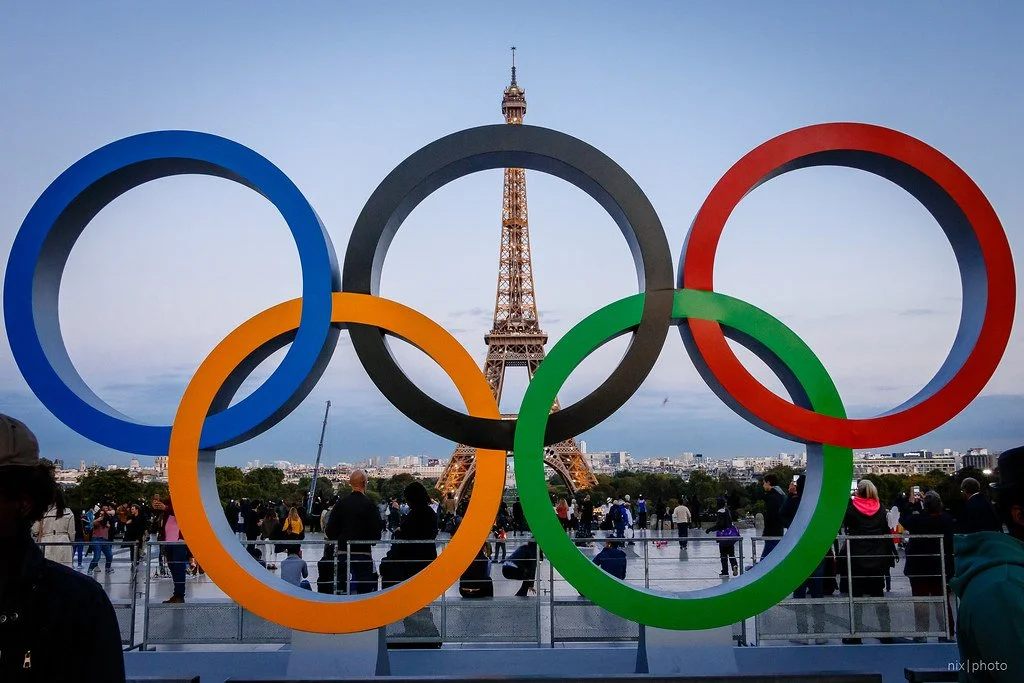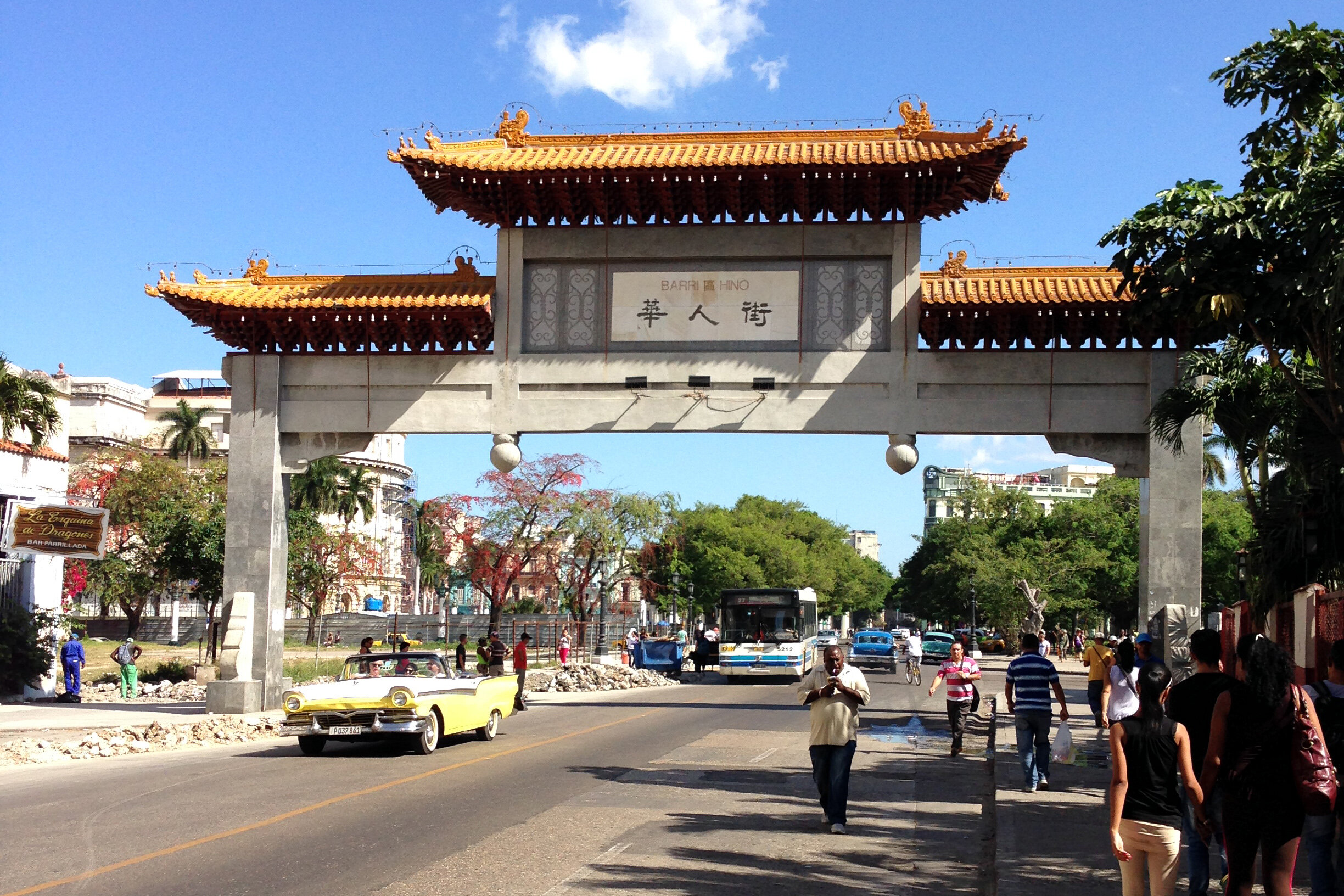In France, the debate on childfree hotels, restaurants, campsites and resorts is coming to a head.
Read More6 Best International Films Showcased at Cannes
From political thrillers to coming-of-age dramas, the 2025 Cannes Film Festival showcased stories about family, power, survival and more. Here are this year’s major award winners.
Read MoreDirty Water: The Frantic Rush to Clean the Seine Before the 2024 Olympics
Officials of the French government are trying to clean the Seine, which has been deemed unswimmable for a century, in time for the 2024 Summer Olympics swim competition.
Pont Alexandre III on the River Seine, Billy Wilson, CC BY-NC 2.0
With the 2024 Olympics set for Paris, the French government has faced backlash for its efforts to quickly clean the Seine, the main river that runs through Paris. The Seine is approximately 13 kilometers long and, in Paris, accompanied by 37 bridges. The staple has promoted water travel and inspired classic French songs such as, “Sous le Pont Mirabeau” and “Sous les Ponts de Paris.” The Seine also has a long history of supplying water to Parisians. In Medieval Paris, citizens and street vendors would collect water from the Seine before they had access to running water. In 1802, Napoleon constructed the Canal St Martin connecting the Seine to the Bassin de La Villette with the goal of supplying water via public fountains throughout the city. The River Seine was in wide use, with people engaging in walks along its banks and recreational swimming, until a decree was passed in 1923 that banned such activities due to pollution and waste runoff. News Writer Olivia Craighead explains that, “The city is old as hell, and as such, sometimes sewage ends up in the Seine.” While people are still allowed to visit its banks, the River Seine has been closed to swimmers since the decree. Until the announcement of the 2024 Olympics.
Since the 2008 Olympics, there have been two open water swimming events: the triathlon and the 10k marathon swim. Pierre Rabadan, the deputy mayor in charge of sports, Olympics, and Paralympics, has said that, “Our objective is an Olympic legacy.” In 2015, Paris introduced the "Plan Baignade" (“Swimming Plan” in English), a plan to make the river swimmable for the Olympics and regular citizens by 2024. As a result, the government has invested upwards of $1.5 billion to make their plan a reality. Despite their efforts, test results from the week of June 10 reveal that E. coli levels in the river are over twice the maximum allowed in water for Olympic events. Marc Guillame, a top government official for Paris, says that these recent readings “are not in line with the standards we will have in the summer.” With the Seine, most bacteria is killed with sunlight and warm temperatures, both of which Paris has seen very little of at this point in the summer. Instead, it has endured heavy rain and cloudy conditions. Phillippe Leclercq, an 18 year old living on a houseboat on the River Seine, notes that, “When it’s good, it’s a nice green color, lately it’s just been brown.”
To ease concerns citizens and athletes have about the River Seines’ cleanliness, President Emmanuel Macron and Mayor of Paris Anne Hidalgo have pledged to be the first swimmers. Originally scheduled to take a dip on June 23, the two have moved their swim back to July 14. Hidalgo stresses that this was not due to the condition of the water, but the current weather and political atmosphere: “Yes, I will swim in the River Seine, not now because the weather is not so well in Paris, but also because we have an election. It is not possible to organize the jump to the river during the election.”
Aanya Panyadahundi
Aanya is a student at the University of Michigan studying sociology and journalism on a pre-law path. She loves to travel the world whenever she can, always eager to learn more about the different cultures and societies around her. In her free time, she likes to play the violin, ski, and listen to podcasts
Surfing at 2024 Olympics Destroys Coral Reefs in Tahiti
Teahupo’o locals and scientists protest the building of 2024 Olympic Games infrastructure over environmental and economic concerns.
Surfing in French Polynesia. Duncan Rawlinson. CC BY-NC 2.0 DEED
In preparation for the 2024 Olympics, Paris has placed sustainability at the heart of its environmental ambitions. In keeping with the city's aim to “assume its responsibilities” for the games' environmental and social challenges, there have been many contributions to fight carbon impact, food waste and destructive construction. However, organizers have recently faced backlash for the erection of an aluminum tower in Tahiti, built specifically for the new surfing competition, that has damaged both coral and the competition's reputation.
To take the games to new heights, Paris has decided to host a new surfing competition, set to take place in Teahupo’o, Tahiti. This setting will offer the opportunity to host a unique competition and allow France to engage with its overseas territories. Teahupo’o, described as a paradise and dream spot by surfers and travelers alike, is anticipated to bring fans and athletes together. This influx of people to the island has called for the construction of a new venue; a 14 ton aluminum tower with concrete foundations, set to host 40 people judging and televising the competition.
Coral Reefs in Tahiti. Jeremy H. CC BY-NC-ND 2.0 DEED
On 1 December, a barge intended to help build the tower got caught on a reef and damaged local coral. Save Teahupo’o Reef, a group made up of locals, surfers and NGOs, posted a video showing the broken coral and damaged boat propeller on their Instagram. After this initial damage, work was stopped to find a small barge and better route for it so as to not damage any more coral.
Plans to build the tower have been met with more resistance from locals in the form of social media campaigns or protests. Residents have fought against the construction, claiming that building it risks impacting the marine ecosystem and damaging the coral reef. Scientists based in Hawaii have advocated with locals and defended their call to stop building the tower, citing its environmental impact. Using 3D photogrammetry techniques, the researchers created maps of the reef habitat where the tower is set to be built and of the lagoon that its materials will be transported through. Their findings indicate that Teahupo’o would face devastating effects. Of the 3,500 square feet that this development would impact, there are over 1,000 corals from 20 different species. The cost of this dredging and building is estimated at $1.3 million. One of the scientists, Dr. Burns, offered no recommendation for construction that would minimize reef damage as there will be substantial damage regardless of alterations to the process. He suggested alternative solutions to broadcasting the games that included a judge in a boat, using drones or playing a live video feed, all of which are more cost-effective, environmentally friendly and presumably better aligned with the ambitions of the organizers.
Efforts to protest the tower have primarily come from groups like Association Vai Ara o Teahupo’o, who have created an online petition that has garnered over 223,000 signatures. The group is composed primarily of locals who rely on the marine environment for their livelihood and feel it is an important part of their heritage that they would like to preserve.
Coral Reefs in French Polynesia. Adam Reeder. CC BY-NC 2.0 DEED
Following the barge incident, the Olympic Committee made the decision to reduce the size of the tower by 25%. To decrease the weight placed on the foundations, the weight has been reduced from 14 tons to nine and will instead be installed at the same site as the old wooden tower. The original design required 72 four meter tall rods that would be drilled into the reef, but as a result of the now smaller design, rod length will be shortened so as to not be driven down as far. The tower is also being built in an area with fewer corals, and existing ones will be removed and taken care of to ensure regrowth.
Despite growing concern over the risk posed to marine life, there will be some benefits of the event after the games conclude. These include new infrastructure such as a pedestrian bridge, fiber internet cables and the money brought into the local economy by those renting places to stay for the games.
Paris has certainly given more thought to sustainability efforts relative to other Olympic hosts, and has certainly made concerted efforts to reduce the games' environmental impact. However, it is important to recognize the destruction that the tower has caused and the long-lasting effects that it will have even after the games end. If Paris does intend to follow through on its sustainability goals, it must ensure that the Teohupo’o reef is left undamaged not just for the short duration of the games, but even after they end. In doing this, Paris and the organizers of the games would prove themselves dedicated to both sustainability and the island's people, bringing about a new era of true environmental conservation.
Mira White
Mira is a student at Brown University studying international and public affairs. Passionate about travel and language learning, she is eager to visit each continent to better understand the world and the people across it. In her free time she perfects her French, hoping to someday live in France working as a freelance journalist or in international affairs.
Will the Paris Olympics Be the Green Games?
In preparation for the Olympic Games, Paris invests in sustainable resources to minimize environmental impact.
Paris Olympic Games. Nicolas Michaud. CC BY 2.0
Keeping up the momentum of its previous environmental ambitions, Paris has committed to complete environmental sustainability for the 2024 Olympic Games. This greener approach will be made possible through careful consideration of the event’s chosen venues, operations (catering and accommodation) and transportation.
As a city renowned for its architecture, Paris has addressed one major change that it can make to the games — using existing infrastructure to host events. As of now, 95% of the chosen venues are pre-existing or temporary structures.
The competition zones are divided into two main areas both inside and outside of Paris’ center. Universally connected by the Seine, 80% of the venues are within a 10 kilometer distance of the Olympic and Paralympic Zones, allowing 85% of athletes to stay less than 30 minutes away from their venue. Through the use of existing facilities that require minimal transportation, Paris can host an event that will aid in its goal to, hopefully, halve a previous carbon footprint of 3.86 million tons. The French aim for a decrease in emissions compared to that of the Tokyo Games in 2020. With Tokyo’s post-game estimation of 2.16 million tons of carbon dioxide, Paris has committed to a limit of 1.65 million tons and to offset any indirect impact with climate-positive projects. Meeting carbon emission goals for the games may prove challenging because of these indirect impacts, primarily the substantial travel emissions generated by spectators. This seems a daunting task when compared to the Tokyo games which managed to achieve low net emissions because of the lack of spectators due to the COVID-19 pandemic.
In accordance with the city’s holistic sustainability vision, Paris has placed emphasis on the importance of green catering. As an event that is responsible for serving 13 million meals, embracing sustainable food sources and partnerships now will set the city up for environmental prosperity even after the games.
In recognizing the environmental impact of certain food sources and resulting waste, Paris has quantified its objectives to reduce its carbon footprint. This eco-conscious catering approach is made up of 6 commitments: two times more plant-based food, 100% certified food (food that is sourced, produced and consumed in a responsible way), reduced plastic consumption, recycling of all uneaten food, reuse of all equipment and structures and hiring 10% of workers from professional integration programs. Athletes and spectators will have a wide variety of plant-based options at their disposal, with 60% of food and beverages available to spectators being vegetarian. With 80% of the total food supply being sourced from within France’s borders, the alternatives to traditional cuisine should hardly be noticed as food will be prepared by culinary professionals who are familiar with creating meals that make the best use of the seasonal menu. Expertise from the chefs and localized sourcing will leave little room for waste across both food and its packing. In its drive to cut down on single-use plastic, Paris’ catering teams will exercise the use of plastic alternatives and employ a “reducing, reusing, replacing and recycling” concept on drink and food containers.
Paris’ goal to minimize waste generation and increase localized food sourcing encourages a healthier lifestyle that will extend beyond the games and become a beacon for environmental change. Even during the 2016 Olympic Games in Rio de Janeiro, plastic in the Guanabara Bay made it difficult for sailing teams to compete. This problem only intensified after the games when produced waste registered at over 18,500 tons, most being non-renewables. Despite this, some of the food waste after those games was utilized by an Italian chef, who created meals for the homeless.
The Paris Olympics will not focus only on breaking athletic records, but on breaking new ground for environmental action, particularly in sustainable event management. Through reliance on a well-developed, effective public transit system and localizing operations within France to minimize travel distance, Paris is showcasing a dedication to environmental impact that will extend beyond the games. If successful, this will serve as an inspiring example for how a large-scale international event can align with sustainability goals to change not just experiences, but lifestyles.
Mira White
Mira is a student at Brown University studying international and public affairs. Passionate about travel and language learning, she is eager to visit each continent to better understand the world and the people across it. In her free time she perfects her French, hoping to someday live in France working as a freelance journalist or in international affairs.
5 Cave Painting Sites that Paint a Picture of Prehistoric Life
Cave paintings provide valuable knowledge about the culture of prehistoric civilizations. These five cave painting sites contain some of the oldest and most fascinating prehistoric art from around the world.
Lascaux Cave paintings in France. Bayes Ahmed. CC BY 2.0.
From Argentina to Bulgaria, humans have been creating art since the dawn of civilization. This art is sometimes the only way to glean certain details about prehistoric culture in various parts of the world. Each of the following five sites provides a unique insight into culture, religion, social life and more, as early as the Stone Age, which spanned from about 2.5 million years ago to 5,000 years ago.
1. Bhimbetka Rock Shelters - India
Paintings of animals at Bhimbetka Rock Shelters. Arian Zwegers. CC BY 2.0.
The cave paintings at the Bhimbetka Rock Shelters in Madhya Pradesh, India, date from the late stone age to early historic period. These paintings and carvings reflect many realities of prehistoric life, depicting animals, religious rituals, agricultural practices and social life. Many artifacts have also been found in the Bhimbetka Rock Shelters, such as stone tools likely used for agricultural purposes. Because of the significant facts about early Indian life that have been provided by this cave art, the Bhimbetka Rock Shelters have been declared a World Heritage Site.
2. La Cueva de Los Manos - Argentina
Handprint paintings. Ryan Somma. CC BY-SA 2.0.
La Cueva de Los Manos or “the cave of hands” is aptly named; this cave painting located in Santa Cruz, Argentina is mostly a collection of handprints, estimated to have been created between 9,500 and 13,000 years ago. The handprints are believed to have been made from mineral pigments by early hunter-gatherer tribes. The meaning of the hands is unknown, but some have theorized they represent an initiation of teen boys into adulthood, due to the size of the hands. In addition to the hands, the cave also contains paintings of animals such as llamas, birds and pumas.
3. The Magura Cave - Bulgaria
Paintings at Magura Cave. Klearchos Kapoutsis. CC BY 2.0.
The Magura Cave in Belogradchik, Bulgaria contains an extensive number of paintings made of bat droppings between 4000-8000 years ago. There are approximately 700 paintings in the cave. The paintings depict anything from people dancing and hunting to religious rituals. The cultural significance of the themes painted, as well as the sheer number of paintings, makes the Magura Cave a significant cultural monument.
4. Lascaux Cave Paintings - France
Painting of an animal in Lascaux Cave. Christine. McIntosh. CC BY-ND 2.0.
The paintings of the Lascaux Cave in Dordogne, France are estimated to be 15,000-17,000 years old, stumbled upon by a group of teenage boys in 1940. Interestingly, among the approximately 600 paintings and 1,500 engravings, there is only one image of a human, making this site differ significantly from the others mentioned, which all depict daily human life in some way. In fact, the human form painted has the head of a bird. Other than this, most of the paintings are of various animals, both real and imaginary. What would be known as a modern day unicorn is even depicted. The Lascaux Cave tells us more about the imagination and storytelling practices of the people of prehistoric France than it does their concrete, daily practices.
5. Laas Geel - Somalia
Cow at Laas Geel. Najeeb. CC BY- SA 2.0.
Laas Geel, in Hargeisa, Somalia, is a collection of rock paintings discovered in 2002. Laas Geel depicts cows, painted with a vibrant red pigment. What is interesting about these cows is that they appear to have some type of ceremonial necklace or hanging around their necks. Many of the cows also appear to be wearing crowns or have some sort of halo-like object around their heads. The cows are often depicted next to humans and dogs. These depictions indicate that cows played some sort of ceremonial role, bringing up important questions about early religion and culture in Somalia.
Calliana Leff
Calliana is currently an undergraduate student at Boston University majoring in English and minoring in psychology. She is passionate about sustainability and traveling in an ethical and respectful way. She hopes to continue her writing career and see more of the world after she graduates.
A Pilgrimage to Lourdes: Why a Tiny Town in France Attracts so Many Visitors
Every year, 6 million pilgrims descend upon the town of Lourdes. Explore how the town’s history and developments in the Catholic Church made it so popular.
Lourdes Eucharistic Procession. Lawrence OP. CC BY-NC-ND 2.0.
In 1858, 14-year-old Bernadette Soubirous, purportedly saw visions of the Virgin Mary by a spring in Lourdes, a tiny French town in a remote corner of the Pyrenees Mountains. It was almost unbelievable that the Virgin Mary decided to reveal herself to Soubirous, a poverty-stricken, sickly, illiterate girl. The town was immediately thrown into upheaval, with some questioning the veracity of the apparitions and others trying to see the sight themselves. Nobody else besides Soubirous ever saw the apparitions. But the spring besides the Grotto where she saw the apparitions was later revealed to have healing powers. The town was put on the map, and pilgrimages started soon after, continuing to this day.
The story of how Lourdes became so popular is intricately linked to the developments in the Catholic Church. After the horrors of the French Revolution, Catholics found solace in miracles, pilgrimages and processions. The 19th century was an era of Catholic revival, with an increase in devotion to the Virgin Mary. In 1854, Pope Pius IX proclaimed the dogma of the Immaculate Conception of Mary, meaning Mary was preserved from original sin. The appearance of Mary just four years after that proclamation threw the town into great excitement. The apparitions at Lourdes and the subsequent pilgrimages fit into the pattern of Catholic revival of the time.
That century also saw the consolidation of papal power in Rome. Papal authority became more prominent as Catholics became increasingly loyal to Rome. While there were other alleged Marian apparitions reported in the 19th century, Lourdes became the most famous because it had the Vatican stamp of approval. Pope Pius IX declared Lourdes an official pilgrimage site in 1876, demonstrating the increasingly tight link of remote villages to Rome.
The pilgrimages to Lourdes also reflect the expanding reach of the globalizing Catholic Church. Pilgrims going to Lourdes were not limited to Europeans; they came from all over the world. According to John T. McGreevy, a Bengali journalist made the trip to Lourdes and found “infallible proof” of God. Vietnamese soldiers in France during World War I toured Lourdes soon after their arrival. The diverse group of people who visit Lourdes show that the Catholic Church has become a transnational institution.
Lourdes Grotto. Kecko. CC BY 2.0.
Not only did the diverse array of visitors reflect the globalization of the Catholic Church, but the export of Lourdes to places around the world proved the same. Not long after people first became fascinated with Lourdes, aspects of Lourdes diffused to the home countries of visitors. The result was the creation of numerous replicas of Lourdes Grottos around the world, from the Vatican Gardens to Northern Indiana to Aruba.
Today, Lourdes is a vibrant community—much more than the sleepy village of 1858—that attracts 6 million visitors annually from around the world. But tradition is still observed. Catholic Masses take place daily in the Sanctuary of Our Lady of Lourdes, and processions are still a common occurrence. People bathe in the water from the springs, hoping for a miraculous healing. Despite the global reach of the village of Lourdes, it still manages to preserve the Catholicism that brought it to fame.
Bryan Fok
Bryan is currently a History and Global Affairs major at the University of Notre Dame. He aims to apply the notion of Integral Human Development as a framework for analyzing global issues. He enjoys hiking and visiting national parks.
Abuse in France’s Catholic Church: Report Finds Victims Number More Than 200,000
An independent commission found that for the last 70 years, hundreds of thousands of children were abused by clergy in France, and the church was ill-equipped to respond to and prevent abuse.
“Notre Dame, Paris.” Gary Campbell-Hall. CC BY 2.0
The Independent Commission on Abuse in the Church (CIASE) was published after an extensive three-year investigation. The report found that over 200,000 minors were abused by clergy members of the Catholic Church in France alone from 1950 to the present day. Furthermore, the commission estimated that, including laypersons who were employed by the church, such as staff in Catholic schools, the number of victims rose to 330,000 over the years.
The report also found that while family or friends in France perpetrated the highest rate of sexual violence against minors, the Catholic Church is the second environment with the highest prevalence of sexual violence. The report estimates that the number of perpetrators ranges from 2900 to 3200. While this number may seem low for the number of victims, the commission notes that “scientific research shows that a sexual predator can effectively assault a great number of victims, especially predators of male children- as is overwhelming the case in the Catholic Church.” The Vatican released a statement that the Pope learned of the report’s staggering findings with “sorrow.” Pope Francis stated, “I would like to express to the victims my sadness… my sorrow for the trauma that they have suffered. And also my shame” in response to the report’s findings.
The report found that the Catholic Church did little to prevent the abuse over the last 70 years, stating, “The Catholic Church’s attitude has evolved over time but it has remained too focused on the protection of the institution, for a long time with no regard to the victims.” Furthermore, the commission found that from 1950 to 1970, the church was focused on avoiding scandal and often saved aggressors by silencing victims. The report found that while the institution did not accept the violence, it was too focused on preserving the institution and did not know how to prevent or address the abuse. The commission urges the Church to not just move on from past abuse, stating: “ It is not enough for the Church to claim awareness, albeit too late in the day.” CIASE also said that the church needed to recognize the abuse, and take responsibility and begin a process of compensation.
The report also addresses canon law, finding that victims have “no place” in the law that was unprepared to deal with sexual violence. The report also cited deviations in catholicism where priests are almost elevated to saint status. The over-emphasization of obedience and purity could lead to environments that perpetuate sexual violence.
The CIASE report is not the first of its kind, but change within the Church seems to be slow. The head of the inquiry, Jean-Marc Sauvé, told reporters that until the 2000s’ the church had shown “deep, total and even cruel indifference" towards the victims of sexual abuse.
Dana Flynn
Dana is a recent graduate from Tufts University with a degree in English. While at Tufts she enjoyed working on a campus literary magazine and reading as much as possible. Originally from the Pacific Northwest, she loves to explore and learn new things.
A tunnelbana train in Stockholm. Tony Webster. CC BY 2.0.
10 Metro Systems Around the World to Ride in Your Lifetime
Metro systems exist on every inhabited continent on the planet, being as unique in comparison to one another as are the diverse cultures and communities they serve. Some are highly efficient at moving people from point A to point B, others are rooted in the history of the local community and a few even serve as living art galleries that are ever-expanding. Here is our guide to the 10 must-visit metro systems to ride on in your lifetime.
1. Tunnelbana, Stockholm, Sweden
Serving 100 stations throughout the region, Stockholm’s Tunnelbana, which translates to “tunnel railroad,” is one of the newer metro systems in Europe, opening its first line in 1950. What makes the Tunnelbana unique is that it is considered to be the world’s longest art gallery, featuring an extensive collection of art made by over 150 artists.
2. Buenos Aires Underground, Argentina
The Buenos Aires Underground, known locally as Subte, is the oldest underground railway system in the Southern Hemisphere, dating back to 1913. The system hones in on its historic origins by providing both historic and modern train cars and stations which are spread out across its seven lines.
3. Seoul Metropolitan Subway, South Korea
Featuring 22 lines spread across 728 stations that serve both the heart of the city and rural communities, the Seoul Metropolitan Subway is one of the longest systems in the world. Opening its doors in 1974, Seoul's subway continues to grow, with several line extensions slated to open throughout the decade.
The iconic London Underground sign in front of Big Ben. Defence Images. CC BY-NC 2.0.
4. London Underground, UK
The oldest underground railway in the world, the London Underground began operation in 1863 and has since grown to serve 270 stations. Known in London as “the Tube,” the metro system provides easy access to neighborhoods throughout Central and Greater London, as well as connections to a slew of airports and other transit systems.
A Berlin U-Bahn train in a station. Michael Day. CC BY 2.0.
5. Berlin U-Bahn, Germany
Famous for its eye-catching yellow trains, the Berlin U-Bahn is one of the oldest and largest metro systems in Europe. The system had been partly severed in two parts during the Cold War due to the divide between East and West Berlin. Today it boasts 10 lines serving 173 stations, with an annual ridership of around 553.1 million.
A graffitied metro car in Athens passes in front of the Acropolis. Tim Adams. CC BY 2.0.
6. Athens Metro, Greece
Like Stockholm’s Tunnelbana, the Athens Metro serves as both a rapid transportation system and an extensive museum. In the system’s Syntagma Metro Station is a handful of the nearly 30,000 artifacts from the classical Greek, Byzantine and Roman periods which were excavated during the construction of new system lines in the 1990s.
Two trains in Tokyo pass over one another. David Gubler. CC BY-NC-SA 2.0.
7. Tokyo Metro, Japan
Offering seamless transitions between its stations and those of its counterpart, the Toei Subway, the Tokyo Metro is considered by many to be one of the best metro systems in the world for both convenience and cleanliness. Serving 180 stations across 9 lines, the Tokyo Metro has continued to expand as the city has grown to be the largest by population in the world.
An MTR train in Hong Kong. David Leo Veksler. CC BY 2.0.
8. Mass Transit Railway, Hong Kong
The Mass Transit Railway is a heavily-riden transit system serving Hong Kong Island, Kowloon and the New Territories, with a daily ridership of over 4.9 million. The transit system has a world-renowned reputation for being clean, affordable and reliable, as well as for offering free WiFi at all of the system’s stations.
The lights of a Paris Metro train passing over a bridge. Luc Mercelis. CC BY-NC-ND 2.0.
9. Paris Metro, France
The Paris Metro is a cultural landmark of the city, with stations highlighting the unique Art Nouveau architecture style. It is one of the densest metro systems in the world, consisting of 136 miles of track connecting 304 stations . The Paris Metro is also one of the busiest, being the second most traveled in Europe and tenth in the world.
A Soviet-era metro station in Moscow. Tarnya Hall. CC BY-NC-ND 2.0.
10. Moscow Metro, Russia
An extensive metro system with stations highlighting Cold War-era architecture, the Moscow Metro is the busiest system in Europe, serving 2.5 billion riders annually. The system has 241 stations and has connections to other transit systems like the Moscow Central Circle, Moscow Central Diameters and Moscow Monorail.
Jacob Sutherland
Jacob is a recent graduate from the University of California San Diego where he majored in Political Science and minored in Spanish Language Studies. He previously served as the News Editor for The UCSD Guardian, and hopes to shed light on social justice issues in his work.
The entrance to a Chinatown in Sydney. Lenny K Photography. CC BY 2.0.
Explore 4 Chinatowns from Around the World
Travel to any of the inhabited continents and you will find Chinatowns, historical and contemporary ethnic enclaves of Chinese people outside of mainland China, Hong Kong, Macao and Taiwan. While there is no conclusive count as to how many Chinatowns exist, they will often be found in any community with a history of Chinese immigration.
The first Chinatown is considered to be Binondo, a neighborhood in the Philippines’ capital of Manila that developed in 1594. Since then, Chinatowns have developed around the world, most recently with Tijuana, Mexico’s La Mesa neighborhood in 2012.
The United States is home to some of the most famous Chinatowns, including those in San Francisco, New York City, Chicago and Los Angeles. That said, for those looking to travel abroad, here is a list of some of the most unique Chinatowns to be found.
1. El Barrio Chino, Havana
The paifang marking the entrance to Havana’s Chinatown. Kaldari. CC0.
Located just three blocks away from the Cuban capitol building, Havana’s Chinatown is a relic of prerevolutionary times. The neighborhood, which began to develop in the 1840s with the arrival of the first Chinese immigrants to the island, became the largest Asian ethnic enclave in all of Latin America by the 1920s.
Following the 1959 Cuban revolution led by Fidel Castro and the 26th of July Movement, during which the country became communist, the vast majority of Chinese-Cubans fled to neighboring countries like the United States. However, beginning in the 1990s, the Cuban government began the process of revitalizing the neighborhood centered around its historical roots.
Today, the Chinese-Cuban population in Havana is small. However, visitors to El Barrio Chino have a variety of restaurants and shops to visit, most of which are centered around Calle Cuchillo. Popular favorites include Restuarante Guang Zhou, whose menu offers a blend of Cuban and Chinese cuisine, Sociedad China Chang, which centers its food around a buffet, and Restaurante Tien Tan, whose menu includes fish and pork dishes which utilize the best ingredients from the Chinese and Cuban kitchens.
2. Chinatown, Singapore
An aerial view of Singapore’s Chinatown with the city skyline in the background. William Cho. CC BY-NC-SA 2.0.
While not necessarily an enclave in the traditional sense given that the majority of Singapore’s population is ethnic Chinese, Singapore’s Chinatown is one of the most historically and culturally significant neighborhoods of the city-state. While the appearance of a Chinese community has been documented in Singapore as early as 1330, the neighborhood was not officially designated as a Chinatown until 1822 when British colonizer Sir Stamford Raffles allocated the area west of the Singapore River as such.
Today, Singapore’s Chinatown is one of the most popular in the world. The neighborhood includes historically preserved sites such as the Sri Mariamman Temple, as well as more recent cultural icons like the Buddha Tooth Relic Temple. Likewise, given that the city-state is world-renowned for its food culture, Chinatown is no exception. Popular spots for street food include the Chinatown Street Market, a pedestrian outdoor mall, and the Maxwell Food Centre, which features some of the best hawker center food including oyster cakes, peanut soup and chicken rice.
3. Quartier Asiatique, Paris
A group of performers at Paris’ Chinese New Year parade. Passion Leica. CC BY-NC-ND 2.0.
While many Chinatowns around the globe have been around for centuries, Paris’ Quartier Asiatique is much more recent. In the late 1970s, many refugees from the Vietnam War settled in the 13th arrondissement. This was followed by later waves of ethnic Chinese immigrants coming from Vietnam, Laos and Cambodia. Many of the ethnic Vietnamese immigrants later moved to other parts of France, leaving the neighborhood with a distinct Chinese presence.
Today, Paris’ Chinatown is considered to be the largest by population in Europe. Visitors to the neighborhood have a number of places to visit. The popular Asian supermarket chain, Tang Freres, is based in the neighborhood and offers a number of foods and goods shipped in directly from China. Restaurants such as Noodle Bar and Les Jardines de Mandchourie have some of the best Chinese food in the whole city. Likewise, the neighborhood has an annual Chinese New Year parade in February which is the largest parade in all of Paris.
4. Chinatown, Sydney
People walking in Sydney’s Chinatown. blairwang. CC BY 2.0.
Sydney’s Chinatown has a history rooted in movement. Many Chinese immigrants in the 1850s were drawn to Australia and settled in The Rocks, a neighborhood that gained the colloquial nickname “Chinese Quarter.” However, due to growing anti-immigrant sentiment and racism beginning in the late 1880s, Sydney’s Chinatown transitioned away from The Rocks to Campbell Street in the 1920s, before relocating again to Dixon and Hay streets, where the current Chinatown lies.
Today, Sydney’s Chinatown is world-renowned for its food and attractions. The Chinese Garden of Friendship, located just a block away from Dixon Street in Darling Harbour, was designed in conjunction with Sydney’s sister city of Guangzhou, China, and features carefully cultivated flora and beautiful architecture. Likewise, every Friday at 4 p.m., Dixon Street is taken over by the Chinatown Night Market. The stalls in the market feature everything from street food staples like dumplings and kebabs, to clothing and jewelry imported directly from China.
Jacob Sutherland
Jacob is a recent graduate from the University of California San Diego where he majored in Political Science and minored in Spanish Language Studies. He previously served as the News Editor for The UCSD Guardian, and hopes to shed light on social justice issues in his work.
Maurice the Cockerel: an Unexpected Symbol of the Fight for Rural France
One French couple filed a lawsuit against the owners of Maurice, a rooster, whose piercing call at 6:30 am disturbed their peace. The case sparked outcry all over the French countryside.
Read MoreBy Refusing an Apology to Algeria, France Shows Colonialism is Far from Over
Algerian architecture reflects continued French influence post-decolonization. mariusz kluzniak. CC BY-NC-NC 2.0.
French President Emmanuel Macron announced on Jan. 20 that he has ruled out issuing an official apology to the country of Algeria for past colonial abuses. This follows 59 years of tense relations between the two nations after the conclusion of the Algerian War in 1962, which marked the end of official French colonialism in the North African country.
The announcement comes as a result of a highly anticipated report on the matter of French-Algerian relations commissioned by Macron in 2020. Rather than a formal apology, the report recommends a “memories and truth” commission to review French colonialism in Algeria. Macron committed to setting up the commission in a statement.
The French occupation of Algeria began with an invasion in 1830, and lasted up until 1962 with the end of the Algerian War, which led to independence. During the 132 years of colonial rule, the French committed a number of atrocities against Algerians, including the massacre of an estimated 500,000 to 1 million Algerians throughout the first three decades of conquest, the forced deportation of native Algerian groups and the use of systematic torture against Algerians during the country’s war for independence.
Since Algeria gained independence, the French government has largely remained silent in regard to the atrocities inflicted during the colonial era. In fact, Macron was the first French president to acknowledge the use of torture during the war for independence when he did so in 2018. Macron has since gone on to demand further accountability, including calls for all archives detailing the disappearance of Algerians during the war. However, the Jan. 20 announcement signals that an official apology remains out of the realm of possibilities for the time being.
Decolonization Efforts Remain a Global Necessity
Protesters marching in Philadelphia in support of Puerto Rican independence in 2018. Joe Piette. CC BY-NC-SA 2.0.
Macron’s announcement is the latest reminder of the continued stains of colonialism which remain in the 21st century. While many former colonial powers like France have largely dismantled their empires and relinquished control to local populations, colonialism and the occupation of Indgenous lands still persists to this day around the world.
Both France and the United Kingdom notably retain overseas territories which are remnants of the heights of their empires. France retains varying administrative control in 11 regions outside of Europe, with a combined population of nearly 2.8 million. Conversely, the British control 14 territories which do not form a part of the United Kingdom itself or its European crown dependencies, representing a combined population of approximately 250,000.
Colonialism, however, is by no means limited to European powers, nor is the process itself a relic of the past. The United States, a country whose foundation is rooted in settler colonialism, retains control over five inhabited territories spread across the Pacific and Atlantic oceans which have a combined population of just over 3.5 million, all of whom are ineligible to vote in federal elections. Likewise, Hawaii’s inclusion in the United States as a state is a result of colonialism in the region where the U.S. systematically undermined native rule throughout the 1800s.
Japan, a country which saw the height of its empire come to an end during World War II, retains control over Hokkaido and Okinawa, two islands with distinct Indigenous populations which have both seen independence movements throughout their time with the country.
China is an example of contemporary colonialism: while not specifically setting up colonies in overseas regions, the country invests billions of dollars in projects to develop African nations on largely unfavorable terms, creates artificial islands in the South China Sea to exercise dominance in the region, and continues to squash independence movements in Tibet and Hong Kong.
While movements for independence, apologies and reparations exist to varying extents in all of these regions, the scars of colonialism persist to this day and remain a contemporary issue unlikely to be resolved in the near future.
Jacob Sutherland
Jacob is a recent graduate from the University of California San Diego where he majored in Political Science and minored in Spanish Language Studies. He previously served as the News Editor for The UCSD Guardian, and hopes to shed light on social justice issues in his work.
A train enters a station in Nice, France. Marsupilami92. CC 2.0.
Sleeper Trains in Europe: A Laidback Alternative to Flight Hopping
In a post-coronavirus world, one may expect a sudden boom in flights, trips and vacations. While modern jet-setting is appreciated for its conveniences, sometimes travelers prefer a relaxing journey instead. Living in an age when technology is king and flights are abundant, sleeper trains provide an opportunity to slow the pace of packed itineraries and immerse riders into a unique experience. They can almost be compared to cruises, as the trains function as both transportation and a place to rest. In Europe, sleeper trains have grown in popularity as the pace of life accelerates. There are several sleeper trains, and Norway’s Dovre Railway, Russia’s Trans-Siberian Railway and the Thello between Paris and Venice, Italy, are worth focusing on.
Norway’s Dovre Mountains in the winter. Ggranvik. CC BY-NC 2.0.
The Dovre Railway, Norway
The Dovre Railway, stretching from Oslo to Trondheim in Norway, is one of the only sleeper trains in the country. The rail network in Norway was challenging to build due to the country’s stiff mountain peaks and various tunnels, but it is perfectly suited for those who want to experience this mountainous country without physically traversing the terrain.
A train in Oslo, Norway. Don Ramey Logan. CC BY-SA 3.0.
The Dovre Line specifically winds through the Dovre Mountains, creating stunning views as it travels along the country’s national parks. Nature is close, and musk oxen may even come up to the train when it is stopped.
Musk ox in Dovrefjell-Sunndalsfjella National Park. Fakepeterpan. CC BY-NC-SA 2.0.
In total, the trip takes about seven hours with several stops, but the stunning scenery makes the trip well worth it.
View from inside a Trans-Siberian Railway train. Wazari. CC BY-NC-SA 2.0.
The Trans-Siberian Railway, Russia
Another journey known for its mountain views is Russia’s Trans-Siberian Railway, but the length of the trip is what makes it one of the most famous railways in the world. There are three routes along the railway, and the longest of the three, between Moscow and Vladivostok, covers 5,772 miles and takes seven days to travel. Along the journey, one gets to witness not only the snow-covered Siberian landscape and the Ural Mountains but also cities such as Irkutsk, known as the “Paris of Siberia” for its neoclassical architecture and finely detailed structures.
The Irkutsk Train Station in Russia. Luxury Train Club. CC BY-SA 2.0.
While many opt to stay in hotels along the way, the Golden Eagle train offers travelers amenities such as double beds, a wardrobe, a TV and DVD player, storage space and heated tiles in the shower room. Riding along the Trans-Siberian Railway in this manner confirms why the journey is so famous.
Thello train in the countryside. Bahn.photos. CC BY-ND 2.0.
The Thello, France and Italy
The Thello, which runs from Paris to Venice, Italy, provides an entirely different atmosphere than the previous trips. Connecting two of Europe’s most famous cities, the Thello train stands as the only overnight route from France to Italy. Riding this train allows one to embrace the French countryside before the route bends through the snowy Swiss Alps and dives back into the Italian countryside.
Thello arriving in Milan, Italy. Bahn.photos. CC BY-ND 2.0.
In addition to romantic views, it is also a comfortable trip according to travelers, with plenty of room to sleep and incredible dining options. Being the only train of its kind to travel from France to Italy, it is not a surprise that this train is frequently taken by both Europeans and international travelers.
While sleeper trains are not the most common way to travel, what they provide is an incomparable opportunity to slow down and enjoy the ride.
Renee Richardson
is currently an English student at The University of Georgia. She lives in Ellijay, Georgia, a small mountain town in the middle of Appalachia. A passionate writer, she is inspired often by her hikes along the Appalachian trail and her efforts to fight for equality across all spectrums. She hopes to further her passion as a writer into a flourishing career that positively impacts others.
Greenery overtakes an abandoned train track. Florian Olivo. Unsplash.
4 Abandoned Railroads that Have Been Brought Back to Life
Abandoned railroad tracks are everywhere. Although many trains are still running, they rarely hold the same mysterious charm as the ones that have been neglected. To many, trains signify a bygone era, an old means of transportation, and an opportunity to see the world without the drama of plane flights. While many enthusiasts have created databases of abandoned railroads, there has also been a wave of people who are remodeling these railroads to give them a new purpose and life.
The golden point of the Transcontinental Railroad. J. Stephen Conn. CC BY-NC 2.0
Golden Spike National Historical Park
The Golden Spike National Historical Park is home to the “golden spike,” the final spike needed to complete the United States’ Transcontinental Railroad. Located in Promontory, Utah, this park attracts about 60,000 visitors each year. While the site has an abundance of offerings, its main attraction is the “golden spike” itself. The Transcontinental Railroad was built over a period of six years, with the last spike being laid in 1869. It is worth noting that the Transcontinental Railroad was actually built by two separate companies, the eastbound Central Pacific Railroad and the westbound Union Pacific,. Nevertheless, the Transcontinental Railroad was a symbol of western progress at the time and finishing the railroad was cause for major celebration. The park hosts reenactments of the event every year on May 10, with last year being a celebration of the 150th anniversary of the Transcontinental Railroad’s completion.
A view from New York City’s High Line. Finchermac. CC BY-ND 2.0
The High Line
Located in New York City, the High Line is a refurbished railroad track that allows visitors to enjoy a picturesque 1.45-mile walk above Manhattan’s West Side. The line became fully operational in 1933 and transported supplies such as meat and produce, but it declined in use in the 1980s as people began to favor trucking for supply delivery. Although the High Line was set for demolition, a new project gained traction in the early 2000s that allowed for its conversion. Today, the High Line has integrated a multitude of sustainable practices, community engagement initiatives and small businesses into the overall experience. The walkway is adorned with over 500 different species of plants and trees and there are regular art installations that are either on the High Line or can be seen from it.
A shot of the High Trestle Trail Bridge lit up at night. Tony Webster. CC BY-NC-SA 2.0
High Trestle Trail
The High Trestle Trail, a multi-use 25-mile trail on the outskirts of Des Moines, Iowa, is a popular biking and outdoor activity destination. The High Trestle Trail is one of many rail-to-trail projects, with this one opening in 2011. There are a multitude of amenities nearby, such as a bike shop, restaurants and visitor centers, but the trail itself contains the top points of interest. One such location is the High Trestle Trail Bridge, which has been dubbed “Iowa’s Stonehenge.” After the railway was decommissioned in 2003, Union Pacific wanted to reuse the steel beams of one of the bridges on the route but had no use for the original support structure. The company left 22 huge, 130-foot-tall concrete pillars which used to hold up the bridge. As interesting a landmark as this was, the Iowa Natural Heritage Foundation realized that these poles could have a more practical purpose. After an extensive project costing over $1.75 million, the bridge was revamped and now stands as an impressive light-up art installation that is an ode to the area’s mining history.
Nature, art and train tracks. French_Villain. CC BY-NC-SA 2.0
La Petite Ceinture
This railroad is quite different from the others. It is located in Paris, France, and contains one of the best access points to the city’s catacombs. Additionally, this abandoned rail line is home to an abundance of graffiti and artwork. In terms of natural life, the area is now home to more than 200 different plant species and more than 70 types of animals. La Petite Ceinture was built intermittently between the years of 1852 and 1869 but has been unused since 1934. While the tunnels themselves can be dark and less than pleasant, the open areas of La Petite Ceinture offer an intriguing destination and a beautiful example of how people might organically reclaim abandoned spaces.
Phoebe Jacoby
is a Media Studies major and Studio Art minor at Vassar College who believes in the importance of sharing stories with others. Phoebe likes to spend her free time reading, drawing, and writing letters. She hopes to continue developing her skills as a writer and create work that will have a positive outward effect.
Grasse, France — City of Scents
The city of Grasse, on the French Riviera, is a smell above the rest. The town is known as the perfume capital of the world—and with good reason. Grasse is responsible for producing iconic scents for everyone from Chanel to Louis Vuitton. The town is currently home to over 60 perfumeries—the oldest of which dates back to 1747—and fields of flowers that have birthed the world’s most famous fragrances. Join us as we journey through what might be the best-smelling city on the planet.
France Banned Food Waste in Supermarkets
Millions more meals can reach those who need them.
Produce at a market in Nice, France. M-Louis. CC BY-SA 2.0.
In 2016, France banned supermarkets from destroying or discarding unsold food products, requiring them to donate instead to food banks or local charities.
The law was written by Parliamentarian and former food industry minister Guillaume Garot, who believes that food waste is a national health and safety issue, akin to wearing a seatbelt. The campaign itself was the product of a grassroots movement by anti-poverty and food waste activists which eventually became a petition, lead by local councillor Arash Derambarsh.
Now that food waste has been outlawed in French supermarkets, Derambarsh has set his sights on European and ultimately global policy revisions around the issue. “Food is the basis of life, it is an elementary factor in our existence,” he told the Guardian.
While Derambarsh became a councillor to help people, he reports being called “naive and idealistic” because of the policy he hoped to implement surrounding food waste. “Perhaps it is naive to be concerned about other human beings, but I know what it is like to be hungry,” he said.
“When I was a law student living on about €400 a month after I’d paid my rent, I used to have one proper meal a day around 5pm. I’d eat pasta, or potatoes, but it’s hard to study or work if you are hungry and always thinking about where the next meal will come from.”
Now, grocery store managers in France with a 400 sq meter or larger footprint must sign contracts with local charities and food banks promising their edible expired items, or face a €3,750 ($4,500) fine per infringement.
According to Jacques Bailey, head of Banques Alimentaires, a network of french food banks, 5,000 charities rely on food banks, who in turn, receive almost half their donations from grocery stores. Under the law, these food banks are receiving larger amounts of better quality food products, enabling them to better reach the the people they serve. According to Bailey, an increase as small as 15% in donations from supermarkets will result in 10 million more meals served every year.
And yet, required donations are not the only way that France is fighting food waste. In 2014, Intermarche, one of the country’s supermarkets began selling produce that was deemed too “ugly” to sell at other markets. These “ugly” or misshapen produce are perfectly safe to eat, but have blemishes make them less marketable to consumers, resulting in their disposal before even seeing the grocery store isles. This initiative is particularly effective, as fresh fruits and vegetables are the most difficult items for charities and food banks to come by, and are necessary to a healthy diet. Intermarche’s initiative reached 13 million people after only one month of being implemented.
About a third of food produced is wasted worldwide. France has narrowed the food it wastes to 66 pounds per person every year. In comparison, Americans waste 200 billion pounds of food per year - 40% of all food produced in the country. The waste problem in America is partly due to the lack of regulation surrounding expiration dates, which are often selected at random and do not always reflect when items are safe to consume.
The rest of the world has a lot to learn from France’s policy. NPR writes that communities and governments worldwide are now reaching out to Garot, hoping for information that would help them reproduce France’s law in their own countries. Ultimately this change needs to be made, because, as Garot emphasized, supermarkets are not just businesses, they are places where humanity must be respected.
EMMA BRUCE is an undergraduate student studying English and marketing at Emerson College in Boston. While not writing she explores the nearest museums, reads poetry, and takes classes at her local dance studio. She is passionate about sustainable travel and can't wait to see where life will take her.
In France, This Chapel Rises From a Volcano
If you want to visit the Chapel of Saint-Michel d'Aiguilhe, aka, “Saint Michael of the Needle,” you’ll have to climb up—way up. Located in France, the chapel is perched atop a distinct volcanic plug rising nearly 300 feet in the air. Dedicated to Michael the Archangel, the church was commissioned in 951 by a bishop who wanted to commemorate his 1,000-mile journey back from the Pyrenees Mountains. Today, thousands of visitors make the trek up 268 steps to witness the chapel and its stunning panoramic views.
What Does the #MeToo Movement Look Like in France?
The sexual assault debate in the City of Love.
From the top of Notre-Dame Cathedral. By Pedro Szekely. April 28, 2018.
Last October in the US, a media firestorm erupted in response to many prominent actresses coming forward to accuse producer Harvey Weinstein of sexual assault. In the days after the story broke, women across the world were invited to share their stories of sexual assault and harassment using the hashtag #MeToo. In the safety of numbers, inumerable women came forward to share their experiences, exposing their bosses, CEO’s, and elite, powerful men to the scrutiny of society. But this is all old news. While the movement has had incredible success in America, it has had a different reception in other cultural climates, namely, France.
The French have historically taken a different perspective on sexual allegations than Americans. Take, for instance, the shock and horror Americans expressed when news of President Clinton’s affair with Monica Lewinsky broke, versus the “c’est la vie” air expressed by the French in response to President Mitterand's affair with actress Julie Gayet.
In early January, French actress Catherine Deneuve joined 99 other well-known French women in an open letter to the #MeToo movement. The letter posed a critique of #MeToo, comparing it to a Stalinist “thought police,” and arguing that “what began as freeing women up to speak has today turned into the opposite – we intimidate people into speaking ‘correctly’, shut down those who don’t fall into line, and those women who refused to bend [to the new realities] are regarded as complicit and traitors.” To the crafters of the letter, #MeToo represents a “hatred of men and sexuality,” an American brand of anti-feminine, anti-male feminism. The letter also included an unfortunate phrase regarding men’s right to “pester women.” To some in France, the #MeToo movement seems like little more than a wave of American puritanism, an encore to the McCarthy era witch hunts.
Not surprisingly, the letter exploded on social media where it was condemned as an example of internalized misogyny or, more extremely, rape-apology. Devenue and other signers were largely viewed as out of touch with reality, as glamorous older women whose privilege allows them to forget the fraught workplaces of millenials, or the students who walk home alone at night.
While the writer’s statements do pose a kind of reality check to the #MeToo movement, their statements on men’s so-called right to “pester women” and emphasis on men's role as the seducer, emphasize their experience of an older culture in which male subjectivity was a natural right. While the writers paint a rosy picture of sexual freedom apart from what they see as an American-inspired wave of “puritanism,” the emphasis on female objectivity and passivity, of being pursued, has no point of reference in the worlds of ordinary French women. Sure, women enjoy to flirt and be flirted with (as do men), but to claim a grey line between this and assault smacks of the predatory sexism that sparked the #MeToo movement in the first place. “If that’s your fetish, if that turns you on, there’s a problem," Rania Sendid, a medical student at Sorbonne University told NBC. "She doesn’t speak for me.”
Nevertheless, according to feminist and historian Michelle Perrot, the writers, “are triumphant free women who show a certain lack of solidarity with the #MeToo victims … But they say what they think, and many people share their point of view. The debate is real and must be recognised.” Despite being hailed as outdated or out of touch, the Devenue letter was signed by many millenials. Thus, the divide seems as much ideological as generational.
While the letter was perhaps poorly expressed, it did draw on the fear of many French women that #MeToo represents a brand of moralist, antisexual thinking that is more oppressive than freeing. In some eyes, the movement seems to have morphed from assault victims seeking justice into a culture of revisionism. In an interview with the Atlantic, 55 year old event organizer Jean-Julien Pascalet said that, “we suffered for a long time from religion, which imposed a moral order — saying, 'that’s good, that’s bad.' If we go back to that … it would be terrible, it would be an Orwellian society.” Others object to the trial-via-media occuring in America, saying that disagreements belong in court, not a public blacklist.
In opposition to these points of view are those who recognize that the media blitz of #MeToo was a last resort for women. Due to the statute of limitations, threats, or simply a lack of resources, it is incredibly difficult to even get a rape or sexual harassment case before a court, let alone receive a favorable verdict. Activist Rebecca Amsellem told NBC that the writers of the letter, “don’t represent all women in France,” saying that, “the problem is that the legal system has failed women and has failed victims.” Pauline Verduzier, a French journalist specializing in gender issues, told NBC that, “The statement said if men don’t have the right to be pushy or flirty without asking, without making sure that it’s OK, it’s the end of seduction because seduction is based on men conquering women," she said. "This is not the future; this is the past. This is wrong. Everything in this statement is not for freedom, it’s the opposite.”
The often-overlooked initiator of the public letter, Abnousse Shalmani, is a 41 year old French-Iranian who grew up in Tehran until her parents were forced to immigrate to Paris in the mid 80’s. She is also a rape survivor. In the midst of the uproar over the letter, Shalmani appeared on radio to say that, “we do not dismiss the many women who had the courage to speak up against Weinstein. We do not dismiss either the legitimacy of their fight. We do, however, add our voice, a different voice, to the debate.”
EMMA BRUCE is an undergraduate student studying English and marketing at Emerson College in Boston. She has worked as a volunteer in Guatemala City and is passionate about travel and social justice. She plans to continue traveling wherever life may take her.
28 Millimetres Project
Meet French artist and TED Prize winner JR whose public art installations in France, Sierra Leone, Kenya, Brazil, Israel, and Palestine encourage people to see the world in a new way. INSIDE OUT is his participatory art project that transforms messages of personal identity into pieces of artistic work. “Stand up for what you care about” JR says, “and together we’ll turn the world INSIDE OUT.”
TAKE YOUR PICTURE AND SUBMIT IT TO HIM AT INSIDEOUTPROJECT.NET

























































